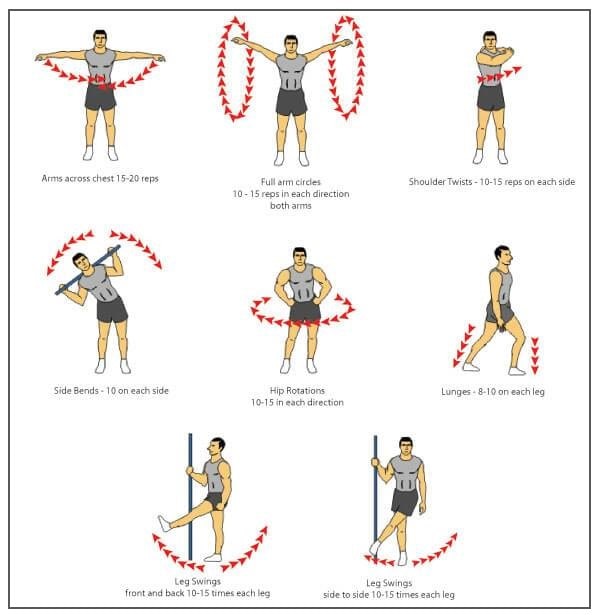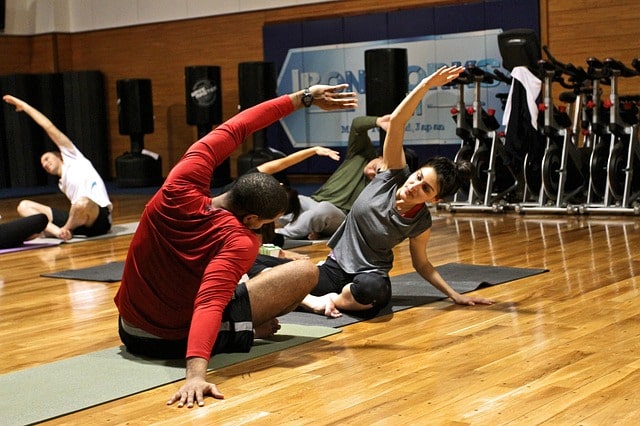A majority of people in the gym don’t concern about doing warm-up before a workout or maybe they don’t know how to do it properly.
People have the same old routine about warm up before a workout. Just five to ten minutes of treadmill or ellipticals, and they jump straight onto the squat rack or bench press and start weight training.
This article will explain to you why you must warm up, how can you do it properly, and what are the benefits of doing warm-up before a workout.
Why You Must Warm-up Before a Workout?
A warm-up before a workout prepares your body for the intense stress that you gonna put on your body in the workout.
It elevates your body temperature and increases your heart rate. This, in turn, increases the blood flow to your muscles. More blood means more oxygen and more nutrition to your muscles which will help to give you a better pump in your muscles during the workout.
A proper warm-up also prepares you mentally for the upcoming workout. It activates your CNS (Central Nervous System) to get ready for the workout session.
Some people may argue that they don’t need to do warm-up exercises before hitting weights as they are done with their whole cardio session. Well, doing cardio before weight training is the wrong way. It should be done after weight training or in a different session altogether.
You may think that warm-up is for beginners only. Well, let me tell you that advanced-level athletes and professional bodybuilders also perform a proper warm-up before a workout.
SUMMARY: Doing warm-up before a workout prepares your body for the workout by activating your neuro-muscular system, elevating your body temperature and heart rate.
Benefits of Doing Warm-up Before a Workout
Warm-up exercises help to get your body ready for intense activities and make it easier to exercise. Some of the most important benefits of a warm-up include:
Lower risk of injury: Not doing a proper warm-up before beginning your workout session is a clear invitation to injuries. Performing warm-up before a workout can help your muscles to relax which, in turn, reduces the risk of injuries.
Better workout performance: Warmed-up muscles can increase your workout performance and can help you work out more effectively. A study done by the Department of Exercise Science, Bloomsberg showed that warm-up improves performance in 79% of the participants examined.
Increased blood flow and oxygen: Warm-up increases blood flow and oxygen supply to your muscles which nourishes your muscles to do more intense work.
Increased flexibility: Doing warm-up before a workout reduces stiffness in your muscles which helps them to move and exercise properly.
Greater range of motion: Stiffed muscles and pain can reduce the range of motion of your joints. A proper warm-up can help you have a greater range of motion.
How Can You do a Perfect Warm-up?
A perfect warm-up routine can be divided into two stages.
First, some cardiovascular exercises to increase your heart rate and blood flow, and after that some dynamic stretching to prepare your muscles for an intense workout.
Let’s dive deep into them…
Cardiovascular exercises
The main purpose of doing cardio, in the beginning, is to increase your heart rate and body temperature.
Doing cardio also increases respiration, which, in turn, increases the flow of oxygenated blood into your muscles.
For doing cardio it is not necessary to jump on a treadmill or stationary bike. You can also choose to do jumping jacks, rope skipping, or on-the-spot running.
Whichever way you choose to do cardio, make sure you gradually increase your pace. Don’t shock your body by increasing the intensity immediately.
When you feel that your heart rate has increased and your body temperature has risen, you can stop doing cardio and go on to do dynamic stretching.
SUMMARY: The main purpose to begin with cardio is to increase your heart rate and respiration, which increases the flow of oxygenated blood in your muscles. 5-10 minutes of cardio is sufficient.
Dynamic Stretching or Dynamic Warm-up
You may have heard of the terms dynamic stretching and static stretching, and wondered when to do them and how they are different.
Static stretching is holding a stretch without doing any movement, usually only at the end range of a muscle. Whereas dynamic stretching is done while moving through a range of motion.
Static stretching is done after the completion of a workout. It helps in increasing flexibility and reduces muscle soreness.
Dynamic stretching is something that is done prior to the workout session. It basically informs your muscles that they are going to use up extensively in the next few minutes.
In simple words, dynamic stretching means taking your joints and muscles through a full range of motion in different planes.
Here are some examples showing how to perform dynamic stretching exercises before a workout.

After doing this, you can do some body-weight squats, lunges, pushups, and pull-ups. Now you are good to go to hit the weights.
SUMMARY: After finishing cardio, do some dynamic stretching exercises for 5-10 minutes. After that, you can also do some squats, lunges, pushups, and pull-ups.
How Long Should You Warm-up Before a Workout?
The overall duration of your warm-up should be around 10-15 minutes. However, it depends on your workout intensity, the more intense your workout is, the longer you need to warm up.
Do more focus on those muscles and joints which you are going to use in your workout. For instance, if you are going to train your chest, then do a thorough warm-up of your chest muscles, shoulder joints, and wrists.
The Bottom Line
Warm-up is a very important part of any workout routine. Though some people avoid it your body needs some kind of activity to get your muscles warmed up prior to an intense workout.
The main goal of doing a warm-up before a workout is to maximize performance and prevent injuries. Try to make it a habit of spending at least 5-10 minutes on warm-up exercises before hitting the weights.





One Comment on “How To Do Warm-up Before A Workout?”
Comments are closed.